キーワード: 生物多様性、進化、相互作用、生態系、環境
http://www.sugadaira.tsukuba.ac.jp/
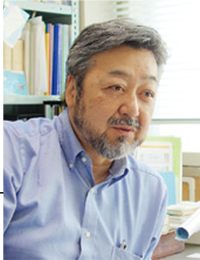 現代生物科学は、生命現象を細胞・分子・遺伝子にまで分解し分析的に捉える分子生物学的手法の開発とともに飛躍的に研究が進みました。しかし、このような方法だけで、本当に生き物を理解した、と言えるのでしょうか? リサーチユニット「生物多様・分類・生態研究ユニット」は、生き物をより深く理解するために、筑波大学の伝統である生物多様性・生態系研究の流れを引き継ぎ、生物間および生物-環境の相互作用の観点も含めた総合的な視点から強靭な生物観の構築に挑戦しています。
現代生物科学は、生命現象を細胞・分子・遺伝子にまで分解し分析的に捉える分子生物学的手法の開発とともに飛躍的に研究が進みました。しかし、このような方法だけで、本当に生き物を理解した、と言えるのでしょうか? リサーチユニット「生物多様・分類・生態研究ユニット」は、生き物をより深く理解するために、筑波大学の伝統である生物多様性・生態系研究の流れを引き継ぎ、生物間および生物-環境の相互作用の観点も含めた総合的な視点から強靭な生物観の構築に挑戦しています。
生き物をまるごと理解する、1000 種昆虫トランスクリプトーム進化プロジェクト
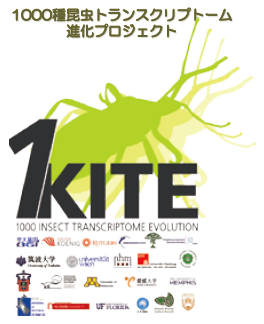 地球には多様な生き物が存在しています。これらの生き物は、太古の海で生まれた共通の祖先がより複雑な生命へと変化する過程で誕生したと考えられています。分子生物学的手法の発展により容易に生物のアミノ酸配列や遺伝子の塩基配列解析ができるようになったことから、生物が進化してきた道筋(系統)を遺伝子や分子に分解して理解する分子系統学が盛んに行われています。しかし、歴史的な事実である進化を理解するためには、分子系統解析だけでなく、古生物学、形態学などからの検証を統合的に理解することが不可欠です。私たちは総合的な視点からの「進化の描写」を目指しています。たとえば、世界13 カ国・地域、43 研究機関の研究者101 名が参加する国際研究プロジェクト「1000 種昆虫トランスクリプトーム進化」コンソーシアム(1KITE)を推進し、昆虫の全分類群をカバーする103 種の膨大なゲノムデータに基づく昆虫の目(もく)間の頑健な系統関係の解明に成功しました(図1)。
地球には多様な生き物が存在しています。これらの生き物は、太古の海で生まれた共通の祖先がより複雑な生命へと変化する過程で誕生したと考えられています。分子生物学的手法の発展により容易に生物のアミノ酸配列や遺伝子の塩基配列解析ができるようになったことから、生物が進化してきた道筋(系統)を遺伝子や分子に分解して理解する分子系統学が盛んに行われています。しかし、歴史的な事実である進化を理解するためには、分子系統解析だけでなく、古生物学、形態学などからの検証を統合的に理解することが不可欠です。私たちは総合的な視点からの「進化の描写」を目指しています。たとえば、世界13 カ国・地域、43 研究機関の研究者101 名が参加する国際研究プロジェクト「1000 種昆虫トランスクリプトーム進化」コンソーシアム(1KITE)を推進し、昆虫の全分類群をカバーする103 種の膨大なゲノムデータに基づく昆虫の目(もく)間の頑健な系統関係の解明に成功しました(図1)。
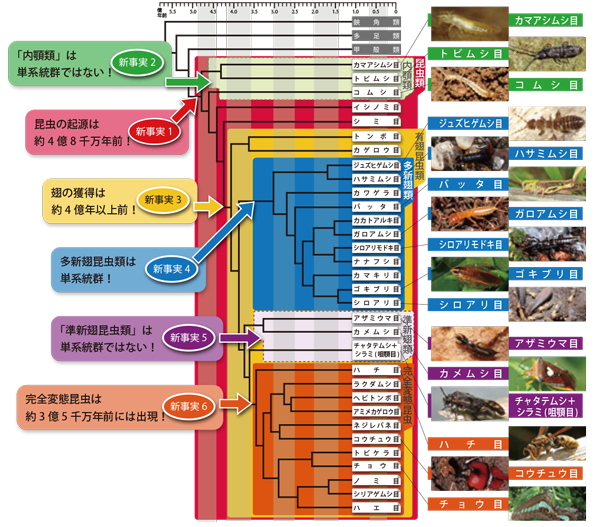
図1:1KITE により明らかになった昆虫の新たな系統関係
筑波大学の学問的蓄積とフィールドを最大限に活かす
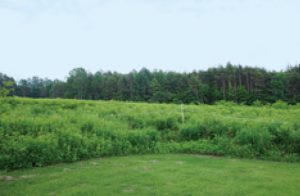
図2:100 年分の植生遷移が観察できる菅平高原実験センター
筑波大学生命環境系は系統分類学、生態系研究において伝統的な学問的蓄積があり、本学ほど多様な生物群を対象とした研究を精力的に展開している大学はほかにありません。また、リサーチユニットの構成メンバーの数人も所属している菅平高原実験センター(*1) には、発足後80 年の間に計画的に放置した二次遷移系列(*2)があり、もともとの自然林と併せると約100 年分の植生が観察できる貴重なフィールドを有しています(図2)。これらの資源を基盤に、本ユニットでは、生物多様性、生態系、生物環境系相互作用の解明を目指し、また、これらの研究をつうじ、現代社会が抱える諸問題(地球環境悪化、災害、エネルギー問題など)を解決するのに不可欠な生物環境のデーターを提供したいと考えています。
*1:平成29年4月1日、山岳科学センター菅平高原実験所に改称。
*2:二次遷移系列:人為的な伐採によりはじまった植物群の遷移のこと。
社会への貢献・実績
- 「発酵茶由来高分子ポリフェノールによるサルコペニアの予防と発症遅延」に関する特許取得
- 菅平高原実験センターフィールドに産する微生物のバイオリソース化
- 『週刊上田』での連載
- 『菅平生き物通信』の発行
- 教育関係共同利用拠点「ナチュラルヒストリーに根ざした森と草原の生物多様性教育拠点」としての活動を実施
取材:平成26年6月27日
Biodiversity and Ecosystem Research Unit
Unit name:Biodiversity and Ecosystem Research Unit
Keywords: biodiversity, evolution, interaction, ecosystem, environment
 Modern biological sciences have dramatically advanced with the development of molecular biological techniques to analyze life phenomena at cellular, molecular, and genetic levels. However, do we really understand organisms? Our research unit “Biodiversity and Ecosystem Research Unit” intends to establish biological perspectives from comprehensive viewpoints, including interactions between organisms and their environments, by taking over the traditions of biodiversity and ecosystem research at the University of Tsukuba, in order to gain a better understanding of organisms.
Modern biological sciences have dramatically advanced with the development of molecular biological techniques to analyze life phenomena at cellular, molecular, and genetic levels. However, do we really understand organisms? Our research unit “Biodiversity and Ecosystem Research Unit” intends to establish biological perspectives from comprehensive viewpoints, including interactions between organisms and their environments, by taking over the traditions of biodiversity and ecosystem research at the University of Tsukuba, in order to gain a better understanding of organisms.
1K (1,000) Insect Transcriptome Evolution (1KITE) Project to understand all organisms
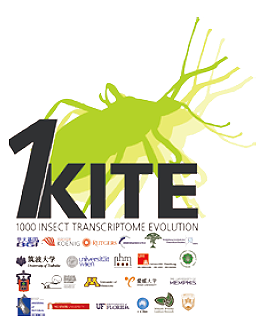 Various organisms exist on the earth. They are believed to share an ancestor, which was born in the ancient sea and evolved into more complex lives. Advances in molecular biological techniques have facilitated the analysis of nucleotide and amino acid sequences, improving the understanding of phylogenies at genetic and molecular levels. However, understanding a series of historical facts, evolution, requires comprehensive examinations, including paleontological and morphological, as well as molecular phylogenetic analysis. Our goal is “depiction of the evolution” from comprehensive viewpoints. For example, we have promoted 1K (1,000) Insect Transcriptome Evolution (1KITE) Project with 101 researchers from 43 institutions in 13 countries and regions, successfully elucidating phylogenetic relationships among various insects based on huge genome data obtained from 103 insect kinds, covering the entire taxonomic groups of insects (Figure 1).
Various organisms exist on the earth. They are believed to share an ancestor, which was born in the ancient sea and evolved into more complex lives. Advances in molecular biological techniques have facilitated the analysis of nucleotide and amino acid sequences, improving the understanding of phylogenies at genetic and molecular levels. However, understanding a series of historical facts, evolution, requires comprehensive examinations, including paleontological and morphological, as well as molecular phylogenetic analysis. Our goal is “depiction of the evolution” from comprehensive viewpoints. For example, we have promoted 1K (1,000) Insect Transcriptome Evolution (1KITE) Project with 101 researchers from 43 institutions in 13 countries and regions, successfully elucidating phylogenetic relationships among various insects based on huge genome data obtained from 103 insect kinds, covering the entire taxonomic groups of insects (Figure 1).
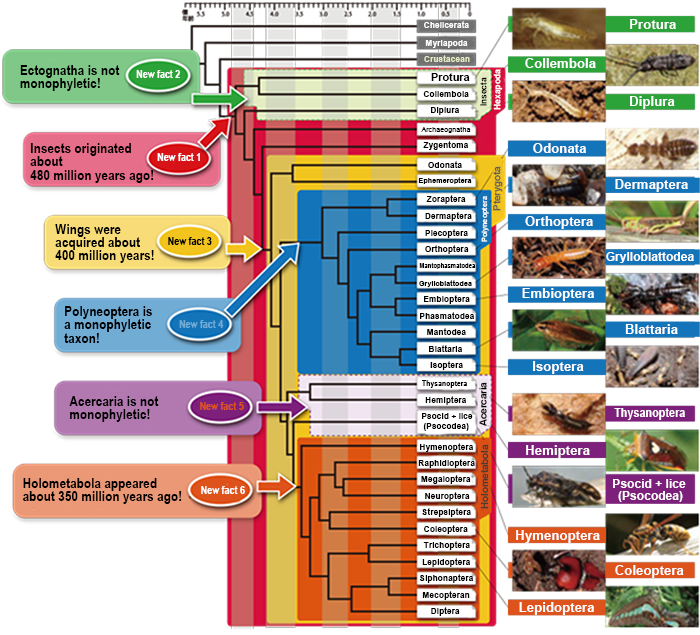
Figure 1: New phylogenetic relationships of insects, revealed by the 1KITE
Utilize the accumulated academic findings and fields of the University of Tsukuba

Figure 2: Sugadaira Montane Research Center to observe vegetation succession for the past 100 years
The Faculty of Life and Environmental Sciences of the University of Tsukuba has energetically investigated diverse organisms, accumulating enormous findings in the fields of phylogeny and ecology, unparalleled by no other university. In the Sugadaira Montane Research Center (*1), from which some of our members are participating in the research, there is a secondary sere, deliberately left for 80 years after the establishment of the center (*2), providing valuable fields, which, in addition to original natural forests, allows observation of vegetation for about 100 years (Figure 2). Using these resources, our unit will elucidate biodiversity, ecosystems, and interactions among biological environments, in order to provide data to solve various social problems of today (global environmental deterioration, disasters, and energy problems).
*1: Sugadaira Montane Research Center has Changed to “Sugadaira Research Station, Mountain Research Center” since April 1st, 2017.
*2: Secondary sere: Sera of plant populations, which are initiated with deforestation by humans
Social contributions and achievements
- Patenting of high-molecular-weight polyphenol derived from fermented tea for delayed onset and prevention of sarcopenia
- Bioresources of microorganisms produced from the fields in the Sugadaira Montane Research Center
- Publication of “ SHUKAN-UEDA”
- Publication of “ Sugadaira Ikimono Tsushin”
- Activities as a joint educational center “Educational Center of Biological Diversity in Forests and Grasslands Based on Natural History”
Interviewed on June 27, 2014
